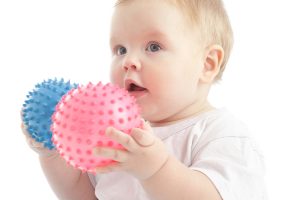 Fine motor skills are often thought of as the movements of the fingers and hands, but they also include movements of the toes, mouth, and eyes.
Fine motor skills are often thought of as the movements of the fingers and hands, but they also include movements of the toes, mouth, and eyes.
Many important tasks related to fine motor skills, like tying shoes, writing, or eating independently develop after the first or second year of life. For this reason, it is common for many parents to de-emphasize this area with their infants and young toddlers. But during their first two years of life, children develop the key foundational elements upon which fine motor skills rely for appropriate development.
Highlights:
|
For example, in order for a child to learn to fasten buttons, among other skills, he first needs to have a good pincer grasp to handle the button, as well as a good hand-eye and bimanual coordination. All of these are skills that a baby begins to develop during his first year. A similar analysis could be done for other complex fine motor tasks like fastening their pants for independent dressing, scooping food and bringing it to their mouth, or grasping a pencil for writing and coloring
In general, for a child to be able to perform these types of tasks and continue to develop other sophisticated fine motor skills, he will first need to be able to:
Perceive the texture, shape and details of an object in his hand
Try to perform any of the fine motor activities above with gloves. Fastening a button, tying a shoe or any other similar task can be significantly more challenging. The thicker the gloves, the more difficult it will be. Similarly, if a child has any type of sensory issue that results in poor tactile perception, he will struggle with these type of tasks. There are plenty of fun activities to support your baby’s sensory development. You can start as early as his first month of life and babies usually love them.
Adequately manipulate the object with his hand
Even if your child has a good tactile perception, he also needs to be able to manipulate the object accurately with his hand. In the example of fastening a button, he needs to be able move the button towards the buttonhole and then line the two up properly. It also requires some strength to be able to push the button through to the other side. Strengthening his hand muscles and learning how to use his fingers with accuracy are crucial to this process.
Coordinate the movements of both hands and arms
Often fine motor tasks require some form of bilateral coordination. Take, for example, cutting paper with scissors. Even if you are very skilled managing scissors, try cutting a simple shape with just one hand. Activities that involve clapping, changing objects from one hand to another or banging two objects in front of their chest can help support the development of your baby’s bilateral coordination. Many of these activities are appropriate when your baby is as young as 6 months old.
Provide the required gross motor stability to comfortably perform the task
Performing most fine motor tasks is very challenging without the development and stabilization of gross motor skills first. Finger movements will be challenging before proper wrist, elbow, and shoulder stabilization and strength is gained. Similarly, wrist, arm, and shoulder coordination will suffer without the strength and stabilization of trunk and core muscles. Supporting your baby’s gross motor development can start in his first month of life with simple activities like tummy time while he is awake. These activities become more interesting as he is able to roll over, sit and crawl.
Without the development of fine motor skills, children will not gain independence with self-care tasks like dressing, bathing, and feeding themselves. Fine motor skills are also important for success in school activities such as cutting with scissors, writing with a pencil, and typing on a keyboard. Because the development of fine motor skills is so essential for your child to be happy and successful, it is important that you facilitate activities that contribute to the development of them.
The BabySparks app offers hundreds of activities to support your baby early on in all aspects of this process, including fine motor skills, bilateral coordination, sensory and gross motor development.








